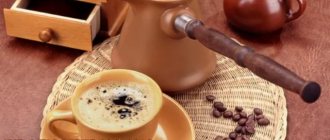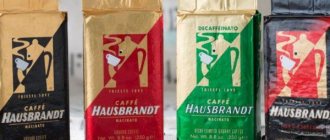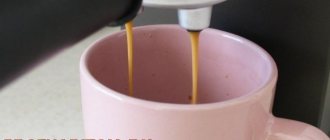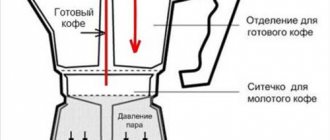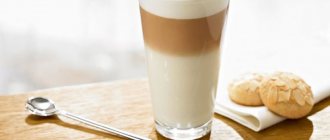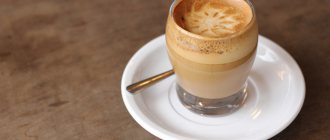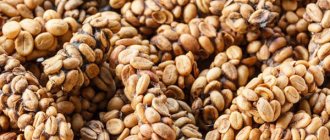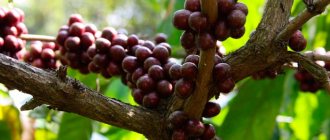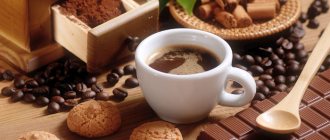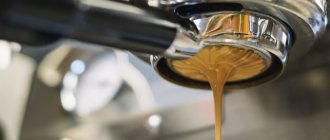Espresso is black coffee prepared in a coffee machine or special coffee maker, where hot water under a pressure of 9 bar is passed through compressed ground beans. The finished drink should have a dense foam (baristas call it crema) of a uniform golden-nut color, at least 2 mm thick. The taste of espresso harmoniously combines sweetness, bitterness and slight sourness. Shades of taste depend on the types of coffee beans included in the mixture, the degree of roasting and the skills of the barista.
The birthplace of the drink is Italy. Espresso is prepared very quickly and drunk just as quickly. It has several variations and serves as the base for many other coffee drinks.
Where did espresso come from and its name?
In Italian, the word espresso means “instantly and specially prepared for you, just.” This version is proven by espresso spaghetti, freshly cut, sold in establishments called spaghetti in the first half of the twentieth century.
Another hypothesis is based on the similarity of the name with the term press. It is clear that it came from the process of brewing espresso under pressure.
The following explanation is related to the word expresso. The well-known espresso is prepared within half a minute.
Italy became the birthplace of espresso at the dawn of the 20th century. And the very first pressure coffee machine was also conceived by the Italians to reduce the brewing time.
Initial experiments produced a drink of worse quality than coffee from oriental cezves. This shortcoming was eliminated by Milanese bartender Achille Gaggia.
It was he who came up with the technology of supplying hot water under high pressure to ground coffee. It was found that the taste of coffee develops better when the water temperature does not reach the boiling point, that is, 100 ° C. At this temperature the burning is not felt.
In the sixties of the twentieth century, espresso spread throughout the world. The Italians, who moved throughout Europe after World War II, opened coffee shops everywhere that served espresso.
It has gained popularity in the USA, Russia and other countries. However, in the east they prefer iced and chilled options.
How to make truly delicious espresso at home? 3 basic rules
There are a number of essential requirements that must be met in order to prepare delicious espresso and not be disappointed. They are all very simple and easy to do.
Rule #1: Quality Coffee
Surely you think that high-quality coffee is expensive coffee. No, not necessarily. Preparing specialty espresso is, of course, more enjoyable, but it is much more important to answer yes to the following questions:
- Is your coffee properly stored and not expired?
- Is your coffee properly roasted and ground?
- Was your coffee ground just before brewing?
If you answered yes to all three questions, half of your success is already guaranteed.
Just in case, let us remind you once again that dark-roasted Arabica or a special espresso blend is best suited for espresso. Of course, different options and taste games with blends are possible, but it’s better to experiment when you can already get good results with dark roasting. The grind should be medium, closer to fine (but not too fine so that particles do not clog the filter). This fraction is the best way to prepare delicious espresso.
Never be tempted to grind more coffee in advance: the fresher the grind, the more aromatic your espresso will be (the longer the ground coffee sits, the more it oxidizes and loses its properties).
When choosing a grain, make sure that it looks “tasty”: the grains should be slightly uneven, but not chipped, different in shape, but always the same in size, oily in appearance and, of course, aromatic. Make sure the coffee has been recently roasted (ideally no more than a month ago).
Roasted coffee is best stored in tinted glass jars, but an airtight foil-lined bag will work just as well.
Rule #2: good water
Everything is simple here. To make coffee, choose clean filtered or bottled water, always without foreign odors and with a low level of mineralization. This will greatly increase your chances of getting a delicious drink.
Rule #3: Clean coffee machine
Regardless of the design of your home coffee machine, it is very important to clean it promptly, thoroughly washing all removable parts. If you have a carob coffee maker, never leave used coffee in the carob. If the machine has not been used for a long time, you should also first clean it of dust and possible scale. After any cleaning, the first 1-2 servings of brewed coffee are considered “household” and are discarded.
A recipe for a home coffee maker that even a child can handle
- Pour water into the reservoir. It should be cold or room temperature.
- Take about 7-8 g of ground coffee (about 2 tsp) per 1 cup (30 ml), place in the compartment provided. If you have a carob coffee maker, be sure to properly compress the coffee in the holder.
- Turn on the coffee machine, selecting the "Espresso" mode, and wait about 30 seconds.
Your coffee is ready! Sugar is added to taste after the coffee machine has finished working.
How to make espresso at home without a coffee machine?
The short answer to the question is: no way. No pressure - no espresso. Everything that you brew in a geyser coffee maker, a Turk, a saucepan, and even a French press will be called differently and have a completely different taste and appearance. Therefore, we have to disappoint you: if you want to drink real espresso, you will have to start a coffee machine. If you do come across a recipe for “Turkish espresso” on the Internet, just know that this is Turkish coffee. And nothing else.
Suitable coffee machines
The best thing, of course, are special super-automatic espresso coffee machines. However, they may not be available to many.
A home coffee making device should have the following characteristics:
It is better to choose a stainless steel holder. A plastic case or holder at high temperatures can spoil the coffee aroma. The drink may acquire a chemical taste and smell.
Pressure no less than 9 bar. The pump must create a pressure of at least 15 bar.
The boiler must create a temperature of 95°C. Excessive heating will give a burnt taste, low heating will result in thin and not very tart espresso.
Isn't espresso coffee?
In fact, these are different drinks. Coffee is a drink obtained through the brewing process. To prepare a good cup of espresso, use Arabica or Robusta beans. Attention is paid to the quality of raw materials.
Expresso does not refer to a specific selection of coffee beans. Specific processing of raw materials is provided, which becomes suitable for preparing a coffee drink. The procedure involves roasting, which gives a more intense product in taste and aroma.
Cooking preparation stage
You should not pour too much coffee into the holder, as it will create problems when tamping. You need to compress evenly. A less dense layer will not prevent the rapid passage of water, resulting in too thin espresso.
You should avoid distempers made from aluminum or plastic. Such fragile products will quickly become unusable.
Stainless steel temperas are preferable. Single holders must have a flat base. Double - rounded.
Rules for making espresso
Classic espresso differs from other types of coffee in the absence of impurities: milk, cream, alcoholic beverages, spices. By adding these ingredients in various proportions to espresso, you can get several dozen other coffee drinks.
Characteristics of espresso (table)
| Bean varieties | A mixture of several varieties of Arabica, possibly adding a small amount of Robusta |
| Roasting degree | From medium (Full City or Viennese) to dark (Italian or French). The darker the roast, the more bitterness the taste and the less sourness. |
| Grinding | Fine or medium espresso |
| Coffee machine pressure | In the espresso chamber - at least 9 bar, pump operating pressure - at least 15 bar |
| Group water temperature | For medium roast coffee – from +91 to +93 °C, for dark roasted coffee – from +88 to +91 °C |
| Ready coffee temperature | At the outlet of the holder spout - +88 ± 2 °C, in the cup - +67 ± 3 °C |
| Cooking duration, seconds | 25–30, depending on the coffee maker model |
| Portion output volume, ml | 25–30 (including foam) |
| Caffeine content (strength) | 50–68 mg (per serving) |
| Recommended intake (servings per day) | 1-3 |
| Maximum permissible norm (servings per day) | 7 |
| Calorie content | 9 kcal per 100 ml, 2.25 kcal per serving |
| Calories with sugar | 21.60 kcal - a serving of coffee with 5 g of sugar (1 sticker) |
Italian coffee connoisseurs believe that the quality of espresso is influenced by 4 factors, which for ease of remembering are called the 4 m rule:
- miscela (mixture) – a well-chosen mixture of grains;
- macinadosatore – grinding;
- maccina – coffee machine;
- mano (hand) – barista skills.
Selecting coffee for espresso
The main advantage of espresso is its full-bodied taste and rich aroma. Arabica has a wonderful aroma, which is why espresso mixtures contain the most of these beans. But if you brew espresso from beans of any one variety, the aroma will be much poorer, “one-sided”, than that of a mixture of different Arabica varieties.
For greater strength, a little robusta is added to such mixtures, which is almost 2 times richer in caffeine. Robusta has one more feature: it produces dense foam.
When buying coffee beans, you need to pay attention to whether there is a foil valve on the package. Only if it is present does the coffee retain its aroma throughout its shelf life.
In specialized stores you can make the mixture yourself, but there they sell loose coffee in paper bags. This coffee retains its aroma for no longer than 2 weeks from the date of purchase.
When purchasing ground coffee in packs, it is important to ensure that it is sealed. After opening the package, it is better not to leave the coffee in the pack, but to pour it into a glass container with a sealed lid. You should do the same with excess self-ground coffee. But after 2-3 weeks of storage, the smell of ground coffee weakens.
The best aroma comes from espresso made from beans ground immediately before preparing the drink. Even if several hours pass between grinding the beans and brewing the coffee, the coffee will have time to become damp and even stale a little.
Ground coffee with aromatic additives is not suitable for making espresso: it is impossible to predict how artificial flavors will behave in an espresso coffee maker.
Grinding coffee for espresso
It is important to know the rules:
- if the grind is too fine, the stream of coffee poured into the cup becomes almost black, and small particles can clog the coffee maker filter;
- When grinding coarsely, the espresso turns out liquid and tasteless.
There is a special fine espresso grind: finer than medium, but coarser than fine. However, you can also use medium grind coffee. Experienced baristas advise using slightly coarser ground coffee in wet weather: this powder absorbs moisture more slowly.
Correct grinding
Choosing a coffee maker
Each model of coffee maker or coffee machine has individual features that are important to study.
Signs of a good espresso coffee maker:
- stainless steel holder. No matter how high-quality the plastic holder is, when heated it adds unpleasant chemical odors to the aroma of espresso;
- the optimal pressure in the espresso chamber is 9 bar, the pump should provide a pressure of 15 bar, you should not buy coffee makers with lower values of these parameters;
- the water in the boiler should be heated to a temperature from +87 to +95 °C. At a lower temperature, the coffee turns out to be liquid and insufficiently extracted; at a higher temperature, there are hints of burning in the drink.
Tamping the coffee in the holder with a tamper is a mandatory step.
Preparing to brew espresso
To make espresso rich and aromatic, you need to take into account some subtleties:
- Even if you want to make the espresso stronger, you cannot pour too much coffee into the holder: in this case, it will be difficult to compact it with a tamper. If the ground coffee is not pressed evenly, water will flow through areas of less density. As a result, the drink will be liquid;
- It is important to choose the right tamper. Preference should be given to stainless steel tampers: aluminum and plastic ones are too fragile. The flat base tamper is suitable for both single and double holders. But Americans prefer to use tampers with a convex (spherical) base for double holders: it compacts the center of the tablet most intensively, and presses the edges against the walls of the portafilter. As a result, the surface area of the particles washed by water increases;
- ground coffee for a carob coffee maker is compressed, applying a force of 19–20 kg to the tamper;
- If you use too hard water, the coffee turns out bland and unflavoured; if you use distilled water, the taste deteriorates and the strength decreases. For espresso you need moderately soft, filtered or bottled water (mineralization – 75–250 mg/l, optimally – 150 mg/l) without chlorine ions;
- the finished coffee should be poured into a preheated cup, preferably a ceramic one;
- espresso cannot be poured from one container to another;
- the foam should be uniform in color. White spots are a sign of excess caffeine in a serving.
You can't make espresso without a coffee machine
Is it possible to get espresso in a cezve?
It is impossible to brew espresso in a cezve. The technology is completely different. In the eastern vessel, the ground coffee is kept in water longer, which is heated gradually. This brewing releases substances in coffee, such as essential oils and caffeine, in a completely different way. Only Turkish coffee can be brewed in the cezve.
origin of name
The word espresso itself, translated from Italian, means “made fresh, here and just for you.” This is how the Italians themselves understand the term. This version is supported by the fact that back in the mid-20th century, freshly cut espresso spaghetti was sold in Italian spaghetti.
However, the espresso brewing process uses pressurized water. Thanks to this, another version of the translation of the name of the drink was born: “compressed”, “made under pressure”.
Characteristics of espresso
The drink is endowed with a number of features.
Volume standard
A classic espresso shot has a strict volume (from 25 to 30 milliliters). In the Russian Federation and Scandinavian countries, water is added to 60-80 ml.
Caffeine
A standard serving contains 50 to 70 milligrams of caffeine. It is recommended to drink no more than 7 cups of standard demitasse per day. These are recommendations from professional nutritionists. Strong coffee is not recommended for regular consumption.
Espresso calorie
Calorie 9 kcal per 100 grams of coffee. The content of coffee affects the energy value. It ranges between 2.5 - 3 kcal.
Types of drink
In addition to the classic version, the following types of espresso are distinguished:
- ristretto. Differs in saturation. Less water is used;
- Lungo. Less strong. In this case, more water is added;
- double, triple espresso . The proportions are respected, but the portion is two or three times larger.
Ristretto
In addition, based on this drink you can prepare:
- coretto. A little alcohol is added to the composition;
- Romano. In addition to the main components, lemon is used;
- Americano. It's essentially watered down espresso;
- cappuccino. Black coffee is covered with milk foam;
- latte. It also contains frothed milk.
The benefits of espresso
Moderate consumption of espresso is beneficial for the body:
- The risk of cancer is reduced;
- Promotes rapid absorption of food;
- Coffee has an invigorating effect. Drinking coffee before sports training increases productivity;
- In men, potency increases; the effect of evening coffee will be different;
- Espresso reduces the desire for food and prevents overeating if drunk between meals;
- A 2008 study from Lund University in Sweden found that drinking coffee reduced the risk of breast cancer;
- And in 2011, the Harvard School of Public Health reported a study of 48,000 men that found that drinking six or more cups of coffee a day reduced the risk of prostate cancer by 60 percent;
- Again, according to the Harvard School of Public Health, people who consume 2 to 4 cups of coffee per day are 50% less likely to commit suicide compared to others;
- Regularly drinking coffee stimulates brain function.
Submission rules
Espresso is served according to certain rules:
- a spoon is placed under the handle of the cup on the saucer, and portioned sugar is placed on the other side;
- hot coffee is served immediately after the preparation process is completed;
- place a glass of water separately;
- The cups are preheated. For this purpose, you just need to pour boiling water over them or use the special heating function in the coffee machine;
- The cups are filled to a maximum of two-thirds.
Negative health effects of espresso
Strong coffee is not recommended for nursing mothers and pregnant women. Caffeine promotes uterine contractions, which can lead to miscarriage or premature birth. Through breastfeeding, caffeine can affect the nervous system of newborns.
A cup of coffee drunk on an empty stomach can cause heartburn, discomfort, and abdominal pain in people with gastrointestinal problems.
Coffee is not recommended for people with pathologies of the cardiovascular system. It increases blood pressure and increases heart rate.
Types of espresso-based coffee
- Cappuccino and latte - espresso with milk and cream.
- Doppio or double espresso is a standard shot doubled.
- Trippio - a shot of espresso, increased three times.
- Romano - espresso with 5 ml lemon juice, sprinkled with zest.
- Americano - espresso with the addition of boiling water. In establishments, separately supplied boiling water serves to independently regulate the strength.
- Coretto - Scotch whiskey or grappa is dripped into espresso.
- Macchiato - a standard shot of espresso poured in a thin stream from above into hot frothed milk. The name of the cocktail comes from the word macchia, which means a brown speck on white foam.
- Mocha - Espresso, hot chocolate, milk and frothed milk all come together to create a cocktail.
- Glace - espresso with ice cream, cold drink.
- Con panna is an espresso shot topped with whipped cream and sprinkled with chocolate shavings.
- Frappe is a cold espresso drink shaken with sugar and added ice.
Espresso based drinks
Many cocktails and desserts are prepared based on this laconic recipe. Adding milk, cream, spices or alcohol turns espresso into cappuccino, latte, iced glass or raff. And the closest “relatives” are ristretto and lungo.
- This is interesting: What is stronger, Americano or espresso
Ristretto
The differences between ristretto and espresso are volume and strength. A serving of ristretto is 2 times smaller than a standard espresso - only 15 ml. But it requires the same amount of ground grain - 7 g. The grind should be finer than for espresso. The amount of caffeine per serving is less, because in 15 seconds of hot steam treatment, the coffee powder does not have time to give up all its strength. But essential oils are completely transferred into water, so the taste and aroma are concentrated. Ristretto is usually prepared in the afternoon.
Lungo
A cup of lungo is 50-60 ml of strong coffee with pronounced bitterness. It requires 7g of coarser ground coffee powder than espresso. Cook for 60 seconds. Because of the length of time it takes to prepare, the drink got its name: “lungo” means “long, long” in Italian. The difference between lungo and espresso is also in strength. In a minute, the coffee powder heats up very strongly, and the caffeine is completely transferred into the water. Lungo is a large portion of strong coffee without a subtle aroma, which is suitable for waking up in the morning.
Drinking espresso
You should take a sip of water first. The liquid will cleanse the receptors. Chocolate (preferably bitter), cheese (preferably hard) or fruit go well with coffee. Meat, fish snacks, beer or wine do not go well with an invigorating drink.
If you keep espresso for a long time after brewing, the quality will deteriorate. Two to three minutes is an acceptable time.
The right time to drink coffee: according to branches of medicine such as neurobiology and chronopharmacology, from 9:30 to 11:30 am.
How to serve and drink espresso
Espresso is served within 1–1.5 minutes after preparation, in special small coffee cups or thick-walled demitasse cups. Along with coffee, be sure to place on the table a glass of still water at room temperature and a stick of sugar (5 g) or a sugar bowl. Sugar is added to the finished drink (optional).
Before drinking coffee, you need to take a sip of water to cleanse your receptors. Espresso must be drunk as quickly as possible, otherwise its taste and aroma will deteriorate.
You can have espresso as a snack:
- chocolate (bitter or with pepper is especially good);
- fruits;
- hard cheese.
- Meats, fish, vegetables, beer and wine do not go well with espresso.
Cooking recipe
The classic espresso recipe requires 7 grams of ground coffee and 40 milliliters of water. Connoisseurs recommend not using sugar and sweeteners, as they spoil the taste of the drink.
For one serving, add 1 tablespoon of beans to a coffee machine with a coffee grinder.
To measure the amount of espresso, use a measuring cup, the volume of which is called an “espresso shot.” Ground coffee must be pressed in a holder with a tamper and placed in the coffee maker. Place the cup in the drop collection and wait 25-30 seconds.
To prepare another espresso-based drink, you need to use the classic method.
There is no such thing as “espresso beans”?
On bags labeled “espresso beans,” the term “espresso” is misleading.
Remember: espresso generally has a stronger flavor than coffee. “Espresso beans” are essentially just a darker roast, designed to satisfy coffee drinkers who prefer a stronger flavored coffee.
You can make espresso using any type of coffee bean; No dark roast needed. In fact, espresso made from lightly roasted coffee beans can taste amazing. "Espresso" refers only to the extraction method.
How to measure the amount of espresso
Professional baristas usually measure the amount of espresso produced according to the Italian standard of 30 ml. However, this does not always work out in the same way and this situation creates a problem.
The fact is that the amount of “cream”, that is, foam, is different with each preparation. Accordingly, the resulting liquid espresso in quantity is significantly different.
Therefore, Western professional baristas recommend not measuring the volume of espresso, but weighing it.
As they explain, the amount of foam produced is influenced by the freshness of the beans, the type of beans, the type of portafilter (holder), pump pressure and a number of other factors. Therefore, the volume of the shot (shot) can vary significantly. Because of this, they recommend that the only quick and accurate way to measure the actual amount of espresso produced is to weigh it rather than measure it volumetrically.
“Brew factor” is the best way to define and differentiate between what is a “ristretto,” “regular espresso,” or “lungo,” they say.
The brew ratio is the ratio of dry ground coffee used to the resulting liquid beverage.
For example, the brew ratio for a 32 gram shot of espresso made from 16 grams of ground coffee would be 16/32 or 50%.
This used to be called "extraction rate", but "brew factor" is thought to be a more descriptive term. This term is already used by the SCAA (Specialty Coffee Association of America) when defining the parameters of brewed coffee.
History of espresso coffee
Strong black coffee is the eternal love of all residents of the Mediterranean coast. But until the 20th century, the drink was prepared only in cezves (Turks), and coffee shop visitors had to wait too long for their order. Therefore, when the Milanese engineer Luigi Bezzera invented the coffee machine in 1901, it immediately became clear that the device had a great future. Already in 1903, entrepreneur Desiderio Pavoni acquired a license and in 1905 began producing Pavoni coffee machines.
The world's first coffee machine by Luigi Bezzera
The novelty delighted the public: now it took only half a minute to prepare coffee, so the name espresso was well deserved. Even before the war, the fashion for coffee machines spread to Italy and France. In 1927, the first coffee machine appeared in one of the bars in New York.
But there were some dissatisfied people. The fact is that in the model of coffee machine invented by Bezzera, the particles of ground coffee overheated, the taste of espresso lost its sophistication, and the tones of burnt beans were felt in it.
The shortcoming was corrected by Milanese bartender Achille Gaggia, who proposed a completely different technology. In the Gaggia semi-automatic coffee maker, pressure was created by a stream of hot water supplied under strong pressure. Since the water temperature in such a coffee maker is below +100 °C, the aroma of the drink is fully revealed, but there is no smell of burnt beans.
The economic situation in Italy after the war was extremely difficult, which is why many residents emigrated to English-speaking countries: the USA, Canada, Australia. In cafes and bars that Italian emigrants opened in foreign lands, they always served espresso coffee. As a result, already in the mid-60s of the last century, the drink gained popularity on all continents. It is loved even in conservative Asian countries, although there they drink espresso chilled, mixed with ice.
